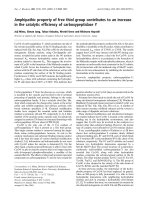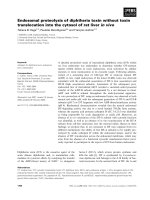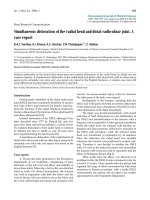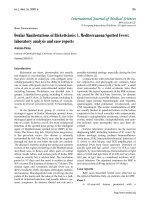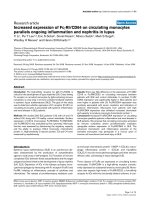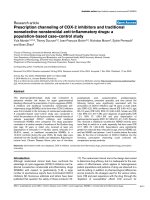Báo cáo y học: " A case of spotted fever group rickettsiosis imported into the United Kingdom and treated with ciprofloxacin: a case repor" pptx
Bạn đang xem bản rút gọn của tài liệu. Xem và tải ngay bản đầy đủ của tài liệu tại đây (254.57 KB, 3 trang )
BioMed Central
Page 1 of 3
(page number not for citation purposes)
Journal of Medical Case Reports
Open Access
Case report
A case of spotted fever group rickettsiosis imported into the United
Kingdom and treated with ciprofloxacin: a case report
Rifat Rashid, Alessandro C Pasqualotto* and David W Denning
Address: Wythenshawe Hospital and The University of Manchester, UK
Email: Rifat Rashid - ; Alessandro C Pasqualotto* - ;
David W Denning -
* Corresponding author
Abstract
Introduction: Spotted fever group rickettsioses are an interesting group of infections, which are
increasing in incidence worldwide.
Case presentation: Here we describe an imported case to the United Kingdom occurring in a
patient who had recently visited Kruger National Park in South Africa – a highly endemic area for
Rickettsia infections. Initial treatment with doxycycline failed but the patient made a prompt
recovery after commencement of ciprofloxacin.
Conclusion: This finding raises the possibility that there are resistant strains of Rickettsia present.
Introduction
Rickettsiae are obligate intracellular Gram-negative bacte-
ria causing acute febrile, zoonotic diseases. Rickettsiosis is
an endemic condition in many areas of the world, and
ticks have an important role amongst the various arthro-
pods acting as vectors [1]. As each tick species has a pref-
erence for particular environmental conditions, tick-
borne diseases are habitually restricted to specific geo-
graphic areas. African tick bite fever, caused by Rickettsia
africae, is probably the most commonly encountered
agent of rickettsiosis in travel medicine. This condition is
endemic in large parts of rural Africa [2] but is rarely seen
in the United Kingdom.
Although most patients with rickettsiosis have a benign
and self-limiting course, complications may occur. These
include prolonged fever [3,4], reactive arthritis [3], acute
neuropsychiatric symptoms [5], sub-acute neuropathy
and acute myocarditis [6]. Proper therapy is considered
essential for rapid recovery and prevention of complica-
tions [1]. However, there is no randomised controlled
trial data to guide treatment. Doxycycline has historically
been considered the drug of choice, and most infected
individuals show prompt response when treated with this
agent. Here we report a patient with spotted fever group
rickettsiosis who failed to respond to doxycycline but who
had a rapid response to treatment with ciprofloxacin.
Case presentation
A 49-year-old immunocompetent Caucasian woman pre-
sented with a 3 week history of fever, shivers, breathless-
ness and weakness. These symptoms started 2 days after
she returned from a trip to South Africa and Zambia,
which included a visit to Kruger National Park. During
this period, she had been fully compliant with anti-malar-
ial prophylaxis (Malarone). She complained of headaches
and light-headedness, which were worse in the evenings
and substantially impaired her ability to concentrate.
Published: 3 April 2008
Journal of Medical Case Reports 2008, 2:98 doi:10.1186/1752-1947-2-98
Received: 11 October 2007
Accepted: 3 April 2008
This article is available from: />© 2008 Rashid et al; licensee BioMed Central Ltd.
This is an Open Access article distributed under the terms of the Creative Commons Attribution License ( />),
which permits unrestricted use, distribution, and reproduction in any medium, provided the original work is properly cited.
Journal of Medical Case Reports 2008, 2:98 />Page 2 of 3
(page number not for citation purposes)
On the first day of symptoms she noticed a painful swell-
ing in the right side of her groin, which gradually
increased in size. A large lesion on her left lower abdomen
was also observed, which evolved from an initial 'white
head' to reveal an eschar that gradually increased in size
(Figure 1). On the next 2 weeks several vesicular skin
lesions emerged on her legs, right arm and abdomen. She
manifested profound anorexia and discomfort in the left
hypochondrium. Musculoskeletal pain and insomnia
were very prominent at this stage.
When seen at our hospital, a left lower abdominal wall
tache noire lesion was noted. In addition, there were 20
small vesicular lesions on her trunk, and she had right
sided painful inguinal lymphadenopathy. Routine bloods
were all normal and malarial films were negative. C-reac-
tive protein was slightly raised at 29. Blood samples were
collected for serological studies on initial presentation
and 2 weeks later (Table 1). A working diagnosis of Afri-
can tick bite fever was made and the patient was started on
doxycycline 100 mg twice daily. On the 3
rd
day of treat-
ment new skin lesions on both her lower limbs were
observed, fever and lassitude persisted and new visual
floaters occurred. Therapy was switched to ciprofloxacin
500 mg twice daily. She responded within 24 hours and
her symptoms resolved completely after 7 days of therapy.
Retrospective serology performed with a commercial
immunofluorescence assay confirmed recent rickettsial
infection. Serological tests for individual Rickettsia species
were not available.
Discussion
The diagnosis of spotted fever group rickettsiosis is diffi-
cult and generally performed retrospectively. Biochemical
abnormalities are usually those of acute phase reactions;
mild and transient lymphopenia, thrombocytopenia and
liver enzyme elevation can be observed. In addition, the
offending organisms cannot be cultivated in cell-free
media but can grow in yolk sacs of developing chicken
embryos and in cell cultures [2], methods of little applica-
bility in clinical practice. The diagnosis of rickettsiosis is
therefore usually established using serological tests, such
as immunofluorescence assays [2,7]. Since cross-reaction
may occur between R. africae and R. conorii, the diagnosis
of African tick bite fever using immunofluorescence can
be presumptive only. Additional tests such as cross-
adsorption studies or Western blotting can provide sup-
plementary information. Many centres also increasingly
perform polymerase chain reaction (PCR) tests as a very
sensitive and specific tool to detect R. conorii and R. africae
in a variety of clinical samples, particularly inoculation
eschar biopsies [2]. However, the occurrence of an inocu-
lation eschar with associated regional lymphadenopathy
– as occurred in our patient – makes the diagnosis of Afri-
can tick bite fever highly probable.
As is the case with most common rickettsioses, African tick
bite fever usually manifests with acute non-specific flu-
like symptoms which include fever, nausea, myalgias and
headache. The time lag from tick bite to symptom onset is
usually 5–7 days [2,6] but may be as long as 12 days [8].
Infections can occur sporadically or in clusters [5,8]. As
mentioned before, the inoculation eschar is the hallmark
for this condition and multiple eschars are seen in up to
54% of patients [2]. This may not be evident in patients
with dark skin. Neck pain and nuchal stiffness are usually
prominent symptoms, and a rash is usually not observed.
Aphthous stomatitis is sometimes seen. Considerable
clinical overlap occurs between African tick bite fever and
the Medititerranean Spotted Fever (fièvre boutonneuse
méditerranéenne), the latter being caused by R. conorii – a
strict intracellular bacterium transmitted to humans by
the dog tick Rhipicephalus sanguineus, mostly in urban set-
tings. While the fatality rate can be up to 4% for Mediter-
ranean Spotted Fever, no fatal case of African tick bite
fever has been described.
Although there is no randomised clinical control trial data
to guide treatment, therapy with doxycycline 100 mg
twice daily for 7–10 days is associated with rapid recovery,
within 24–38 hours, in most patients [2]. Occasionally,
Tache noire lesion seen on the left lower abdomen 8 days after the start of the illness (colour reproduction)Figure 1
Tache noirelesion seen on the left lower abdomen 8
days after the start of the illness (colour reproduc-
tion).
Table 1: Patient's serology to Spotted Fever Group Rickettsioses
(Porton Down specialist pathology laboratory).
Reciprocal Titres
Moment of sampling Ig G Ig M
At clinical presentation Negative Negative
After 10 days ≥256 Negative
Publish with BioMed Central and every
scientist can read your work free of charge
"BioMed Central will be the most significant development for
disseminating the results of biomedical researc h in our lifetime."
Sir Paul Nurse, Cancer Research UK
Your research papers will be:
available free of charge to the entire biomedical community
peer reviewed and published immediately upon acceptance
cited in PubMed and archived on PubMed Central
yours — you keep the copyright
Submit your manuscript here:
/>BioMedcentral
Journal of Medical Case Reports 2008, 2:98 />Page 3 of 3
(page number not for citation purposes)
patients can show a slow response of up to 3–5 days [7].
An interesting finding in our case is that our patient failed
to show any improvement after 3 days of therapy with
doxycycline. As clinical symptoms were actually more
intense on the 3
rd
day of therapy, therapy was changed to
ciprofloxacin, and a rapid response was then observed.
Previous reports of clinical failure with doxycycline are
rare. Jensenius et al. [3] reported that a patient with Afri-
can tick bite fever complicated by reactive arthritis had no
response to 3 days of doxycycline. Similar to our report,
the patient's symptoms resolved with the use of cipro-
floxacin. Parola et al. also described a patient who received
doxycycline for 3 weeks and recovered slowly [4]. In vitro
studies have shown R. africae to be susceptibility to both
tetracyclines and the fluoroquinolones [9], and in vitro
resistance to these antibiotics has not yet been demon-
strated. The possibility of resistant isolates of Rickettsiae
being present in Africa requires further observation and
study.
Conclusion
Spotted fever group rickettsioses are becoming increas-
ingly prevalent amongst travellers to endemic areas in
Africa. These conditions are usually not severe and present
with unspecific flu-like symptoms. Treatment is relatively
simple but requires a high index of suspicion due to the
non-specific clinical findings. Important clues for the
diagnosis of African tick bite fever are the presence of
inoculation eschars (a highly suggestive sign), and the
occurrence of the disease in clusters. Although most
infected patients promptly recover after therapy when
doxycycline is initiated, some patients can be slow- or
non-responders. Ciprofloxacin represents an alternative
therapy, which was effective in the case of our patient.
Competing interests
The author(s) declare that they have no competing inter-
ests.
Authors' contributions
All authors provided an equal intellectual contribution to
this manuscript. The clinical notes were reviewed by RR.
All authors read and approved the final manuscript.
Consent
Written informed consent was obtained from the patient
for publication of this case report and any accompanying
images. A copy of the written consent is available for
review by the Editor-in-Chief of this journal.
Acknowledgements
ACP is sponsored by the Fungal Research Trust.
References
1. Jensenius M, Fournier PE, Raoult D: Rickettsioses and the inter-
national traveller. Clin Infect Dis 2004, 39:1493-1499.
2. Jensenius M, Fournier PE, Kelly P, Myrvang B, Raoult D: African tick
bite fever. Lancet Infect Dis 2003, 3:557-564.
3. Jensenius M, Fournier PE, Vene S, Hoel T, Hasle G, Henriksen AZ,
Hellum KB, Raoult D, Myrvang B: African tick bite fever in trave-
lers to rural sub-Equatorial Africa. Clin Infect Dis 2003,
36:1411-1417.
4. Parola P, Jourdan J, Raoult D: Tick-borne infection caused by
Rickettsia africae in the West Indies. N Engl J Med 1998,
338:1391.
5. Jackson Y, Chappuis F, Loutan L: African tick-bite fever: four
cases among Swiss travellers returning from South Africa. J
Travel Med 2004, 11:225-228.
6. Bellini C, Monti M, Potin M, Dalle Ave A, Bille J, Greub G: Cardiac
involvement in a patient with clinical and serological evi-
dence of African tick-bite fever. BMC Infect Dis 2005, 5:90.
7. Sexton DJ, Corey GR, Greenfield JC, Burton CS, Raoult D:
Imported African tick bite fever: a case report. Am J Trop Med
Hyg 1999, 60:865-867.
8. Caruso G, Zasio C, Guzzo F, Granata C, Mondardini V, Guerra E,
Macrì E, Benedetti P: Outbreak of African tick-bite fever in six
Italian tourists returning from South Africa. Eur J Clin Microbiol
Infect Dis 2002, 21:133-136.
9. Rolain JM, Maurin M, Vestris G, Raoult D: In vitro susceptibilities
of 27 rickettsiae to 13 antimicrobials. Antimicrob Agents Chem-
other 1998, 42:1537-1541.

